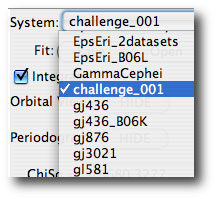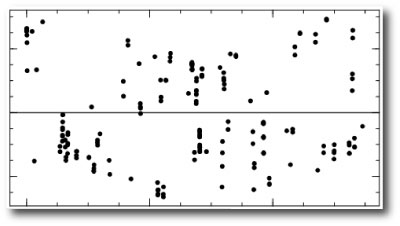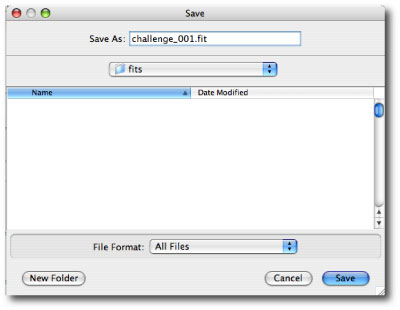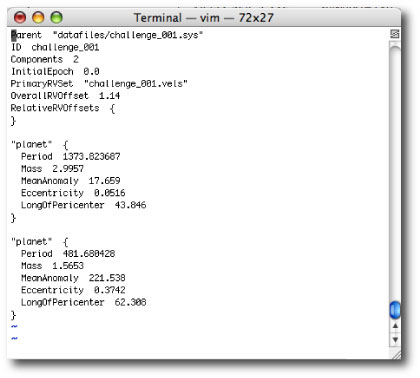
Image Source.
We’re continuing to see a strong influx of new users and activity on the systemic backend. Thanks to everyone who’s taking part! If you’re a first-time visitor to the Systemic Project website, please read the weblog entries that follow this post. They contain the information you need to start participating, and they give a recent day-by-day overview of the project developments.
Now that we’ve got an active user-base for the systemic console, we’re pleased to release the first Systemic Challenge synthetic radial velocity data set. This data set corresponds to a realistic simulated planetary system that is both scientifically interesting and non-trivial to fit.
Sky and Telescope is sponsoring the world’s first radial velocity fitting contest in connection with our challenge system. The person who submits the self-consistent (integrated) fit to the data having a chi-square value closest to one will receive a paperback edition of the Millennium Star Atlas (a $149.95 value).
To participate in the contest, you’ll need to first download a fresh copy of the Systemic Console, which is available as a .zip file on the downloadable console page. You’ll also want to make sure that you’ve gone through the three console tutorials (one, two, and three).
The challenge system is listed as “challenge_001” on the system menu of the console:

The data set itself looks like this:

As is the case with many of the more complex radial velocity data sets, this system can be only partially characterized with a fit that assumes that the planets are on Keplerian orbits. In order to fully characterize the system (and thus get a reduced chi-square statistic that approaches one) planet-planet interactions need to be taken into account. The winning fit, therefore, will need to be self-consistent. That is, the integrate function on the console will need to be enabled.
The console is a state-of-the-art radial velocity fitting code, but it is also a work in progress. Perhaps its most immediate shortcoming is that it is a single-threaded java process. Multiple-planet fitting with integration enabled, however, is a challenging computational problem, and a realistic fit can take literally hours to complete, even on a fast computer. We are working hard to bring a multi-threaded version of the console to the Systemic collaboration, but this is still several weeks away. In the meantime, this means that there is no progress bar to show how the fitting process is doing. Patience and planning will need to be used. Rest assured, however, that it is possible to get the correct fit.
Once you’ve found a fit, use the console’s “save” button to save it in the fits subdirectory (folder) of your systemic directory (folder):

The fit itself is a simple ascii text file. It can be viewed in any text editor. For example:

To submit the fit to the contest, mail it as a plain ascii-format block of text to the e-mail address given on the web page listed in the Sky and Telescope article. Please use “Challenge 001 entry” as the subject line for the e-mail.
A contest FAQ page will go up shortly, but in the meantime, good luck fitting!
By the way, if you’ve developed (or plan on writing) your own software routines for radial velocity fitting, you’re encouraged to jump in and compete! This contest is not off limits to professional dynamicists.

Thanks for letting me know.
Eric
I see what you mean about “non-trivial to fit”.
Presumably one of the entry conditions is actually purchasing the magazine so you can find out what the email address is!
Pingback: systemic - last call